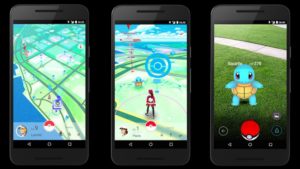Last night as I walked home from the subway, I felt like I was in Vernor Vinge’s Hugo Award-winning novel Rainbows End. Vinge’s works predict a mind-boggling number of technological advancements that have and will come to pass (he’s known in particular for the concept of the technological singularity—the point at which machines are vastly more intelligent than humans, and life as we know it changes completely). In the book, humans spend much of their time interacting with holographic objects and living in an augmented reality (AR) that facilitates everything from work to communication. Vinge picks up on aspects of AR that have already come to pass, such as wearable technology and haptics.

In the book, people who don’t augment their reality are alienated from everyone else, which is how it felt when I passed at least a dozen kids—er, I shouldn’t call them kids, as they seemed mostly in their twenties—in groups of 3 or 4, consulting their phones and looking around, sometimes joined by passersby seeking hints. Walking home on the busy path always involves seeing people shuffle along staring at their phones, but this was the first time everyone I passed was doing the same thing at the same time—playing Pokémon Go. In fact, my boyfriend and I were the only people on the path—apparently, a popular and fruitful Pokéspot—who weren’t playing. The walk offered a glimpse into an inevitable future when people, particular the younger generations, will all be dialed into some technological universe or other while some of us watch from the outside, wondering what we’re missing and wondering how each new technological phenomena will change the world.

The scene also reminded me of Ready Player One, Ernest Cline’s 2011 novel (the movie version, directed by Steven Spielberg, is currently in production), which features a virtual world everyone prefers to the dystopian real one. In one scene, the protagonist rides a bus and everyone has on VR headsets, oblivious to the landscape and to what’s happening around them. Many people are so immersed in this preferable virtual world that they never go outside. The upshot of Pokémon Go is that players have to go outside in search of Pokémon–they have to interact with the real world, rather than ignore it. In a nutshell, that’s what distinguishes the virtual reality of Cline’s novel from the augmented reality of Vinge’s, and what makes Vinge’s depiction particularly spot-on today.

For those who aren’t familiar, Pokémon Go is an iOS/Android version of the popular game first released by Nintendo in 1996 and that integrates Pokémon into real-world locations. Players can track Pokémon using their phones’ GPS (apparently, Pokémon like to breed in busy areas like malls or parks and they hang out in areas that correspond to their type—for example, water Pokémon will frequent rivers, pools, and ponds). To capture a Pokémon, a player turns on the phone’s camera and sees the Pokémon superimposed onto the real-world landscape. With a flick of the finger players can launch balls at the Pokémon in an attempt to catch it. Players can also evolve Pokémon, hatch them from eggs, power them up with candies or stardust, level up, practice combat by taking them to the gym, and use potions and other goods such as beacons, which are visible to other players in the vicinity.
By now you’ve likely read about some of the incidents involving the game. Players have tripped, fallen off skateboards and bikes, twisted ankles by stepping into holes, gotten sunburned, and crashed cars. Some people’s homes and workplaces are at or near Pokéspots (collection points) or gyms, which suddenly makes the area a popular player destination, even the wee hours, and has led police to suspect illegal activity. A teenager in Wyoming found a dead body in a river while playing. Because of the game’s GPS capabilities, robbers in Missouri could predict where other players might go and lured players to remote areas with beacons.
Pokémon Go has caused the bigger stir in AR thus far, but that may soon change as more sophisticated and versatile systems hit the market. Microsoft has been busy working on the HoloLens, a “fully self-contained, holographic computer, enabling you to interact with high-definition holograms.” In the demo below, the HoloLens is used to play mixed reality video games, like Pokémon Go except even more immersive and interactive.
Magic Leap is a major player in AR as well, and is scheduled to announce details and demo of its new product any day now. Reports indicate that it’s similar to the HoloLens, but will use different headgear, and unlike rival companies, Magic Leap (with the help of investors such as Google) has developed all of the hardware and software elements itself.
I couldn’t play Pokémon Go even if I wanted to because I’ve thus far resisted buying a smartphone. But more and more, I can’t help feeling that if I can’t beat them, I may as well join them. After all, I’ve always had an affinity for Psyduck, and if I happened to see one darting about I would take off after it, virtual ball in hand, ready to catch this one, if not all of them.
